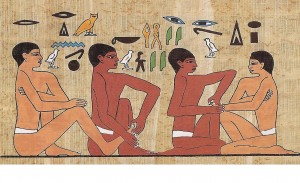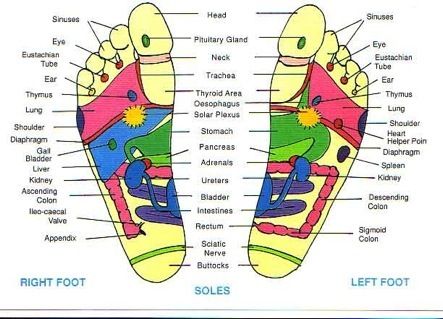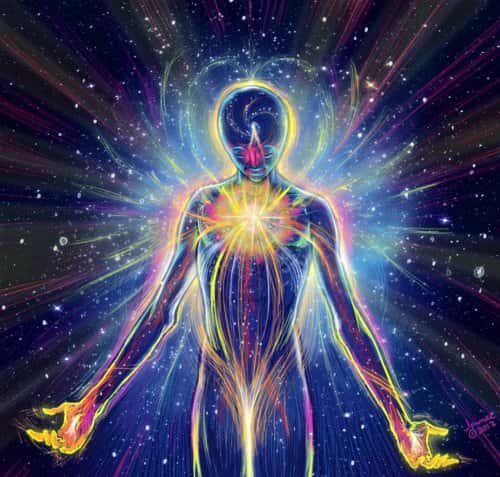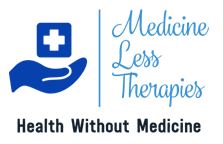Origins of Reflexology:
- In Ancient Egypt and china over 5,000 years ago our ancestors were rubbing each other’s feet.
- In the late 1800s, Europeans invented reflexology: applying pressure to a person’s feet (or hands) in order to affect a physical change to the body.
- Placement of pressure is based on a system of zones and reflex areas that correspond to other parts of the body.
- Also called “zone therapy,” this mixture of healing art and science is based on the premise that an energy channel encompassing 12 vital organs exists from our feet to the tops of our heads.

- Applying pressure with his/her hands, a reflexologist unblocks that channel to restore proper health and organ function.
- Because the principles of foot massage are not in alignment with Western science, reflexology did not come to the United States until the 20thcentury.
- Since then, it has become an increasingly popular alternative therapy – due in part to the current holistic medicine trend. Today, over 20 countries across the globe support reflexology associations. Reflexology is particularly popular in Denmark and the UK.
Reflexology:
Reflexology is based on “reflex areas” on the hands and feet, whose energy is believed to be connected to organs and other body parts.
By applying pressure to the reflex points, the reflexologist can balance your nervous system and stimulate endorphins, the body’s natural pleasure response, which reduces stress and discomfort.
This can be a deeply relaxing therapy, especially if you stand all day or have tired, achy feet. You remove your shoes and socks but otherwise remain clothed.

- Reflexology is the application of pressure to areas on the feet, hands and ears. Reflexology is generally relaxing and may be an effective way to alleviate stress.
- The theory behind reflexology is that these areas correspond to organs and systems of the body. Proponents believe that pressure applied to these areas affects the organs and benefits the person’s health.
- Reflexologists use foot charts to guide them as they apply pressure to specific areas. Sometimes these practitioners use items, such as rubber balls, rubber bands and sticks of wood, to assist in their work. Practitioners of reflexology include chiropractors, physical therapists and massage therapists, among others.
- Several studies funded by the National Cancer Institute and the National Institutes of Health indicate that reflexology may reduce pain and psychological symptoms, such as anxiety and depression, and enhance relaxation and sleep. Studies also show that reflexology may have benefits in palliative care of people with cancer.
- Reflexologists claim that reflexology also can treat a wide variety of medical conditions, such as asthma, diabetes and cancer. However, scientific evidence is lacking to support these claims.
- Reflexology is generally considered safe, although very vigorous pressure may cause discomfort for some people.
FOOT REFLEXOLOGY BENEFITS:
Think about how much stress your feet go through each day. No body part is more abused than your feet. Standing, running, jumping – our feet do it all! Reflexologists believe that overall health begins in your feet and travels up.

The benefits of foot massage are endless – not to mention it feels downright great! Although there are no “hard facts” to prove what a foot massage can really do, practitioners and patients alike claim that reflexology can:
- Cure colds/minor ailments
- Prevent/cure diseases
- Increase energy
- Relieve stress, pain, and anxiety
- Improve blood and lymph circulation
- Prevent injury
- Relieve pain from MS and chemotherapy
- Stimulate activity of internal organs
- Successfully treat liver dysfunction, constipation, IBS, chronic headaches, and skin allergies

Relieve pressure on legs and feet in pregnant women
- The benefits aren’t purely physical. A good foot massage can also improve your mental and emotional state.
- Most of those who seek out a reflexologist are looking for relaxation and stress relief. With less stress in your life, your chance of heart disease drops considerably.
Reflexology Pressure Points:
- As you can see from the chart at left, nearly all areas of the body have a corresponding reflexology point on the foot.
- For example, the dark blue spot on the inner sole of each foot corresponds to the bladder. Applying pressure to this area can affect bladder functioning.
- The right foot corresponds to the organs on the right side of the body, and vice versa.
- Not all practitioners agree on the exact location of reflex points, but there is a general agreement when it comes to the major points.

- Like many holistic practices, foot reflexology is not based in scientific fact. More research is required to discover the hard facts, but scientific documentation does point to linkages between the internal organs and certain locations on the skin.
- For example, a 2008 study (Kunz and Kunz) found that reflexology led to an increase in blood flow to the intestines and kidneys.
- The practice has also been associated with positive changes in kidney functioning (dialysis patients).
- A 2015 study (Song) suggests that reflexology may have a positive effect on diabetics (Type II) and associates the practice with lowering blood pressure.
- Many reviews note that the overall quality of research on reflexology tends to be low.
What to expect from Reflexology:
- Reflexology is not a cure or a medical treatment.
- The goal of reflexology is to release stress/congestion in the nervous system and to balance a person’s energy.
- A reflexology session may be general or it may focus on specific problem areas.
- According to reflexology theory, working the entire foot opens nerve pathways and blockages and promotes relaxation throughout the body.
